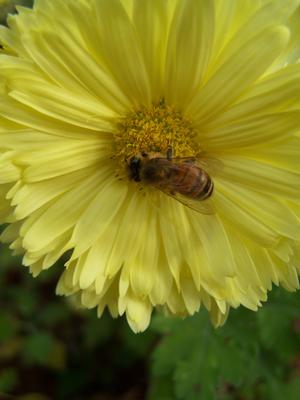Honeybee Colony Collapse Disorder (2011)
Honeybee Colony Collapse Disorder (CCD) has been in the news. Apparently disoriented honeybees fly from the hive never to return. This behavior is completely uncharacteristic of the entirely instinctive insect. The death of the hive is quick. Billions of bees have died since 2006. Larger corporate honey producers tend to have greater incidence of CCD by percentage as do smaller family farms. The reason is simple: smaller honey producers as a rule are more fastidious and better care for their bees whereas large corporations more often do not treat hives as well. Everything from cell phone towers to global warming to genetically modified crops have been scrutinized. To date there is no direct cause for CCD.
Though it is curious that bees avoid nesting in and adjacent to cell phone towers it may be that the emitted microwaves not only annoy but disrupt necessary communications for this incredibly social insect. As to a changing climate wholesale alterations are occurring to numerous plant species in a broad array of ecosystems. These disrupted interrelations are often virtually unfathomable in the depth of their complexity. As part of these changes invading non-native insects may exact a toll upon plants and flowers in some cases to the disadvantage of bees and other pollinators. (Remember: though employing a positive role to farms, gardens and mankind, honeybees are introduced workers - they are not native.)
As reported by ABC News on July 13, 2011 genetically modified (GM) crops have been proven to cause monarch butterfly deaths. Since 2000 we have 40% fewer monarchs due to altered herbicide-tolerant soybeans and corn. As of 2011, 94% of all U.S. grown soybeans are GM. Unfortunately, GM expansion for large scale agriculture will grow. But if GM crops have been proven harmful to monarch butterflies might these crops also be deleterious to other insect populations including honeybees? No one can say presently though it isn't much of a stretch to conjecture a link.
Certainly pesticides such as clothianidin and imidacloprid have been implicated. But to date again no direct scientific evidence draws a straight line to the disorder. It is obviously better to use fewer chemicals rather than more. Broad casted chemicals intended to control a particular bad bug will generally harm beneficial insects, too. Malathion is deadly to bees. It is also important to stress that the "inert ingredients", part of the chemical formulation which are not listed on the label, may in some cases be even more noxious than the listed chemical component(s).
A well-documented problem is the Varooa mite which transmits Israeli Acute Paralysis Virus to honeybees. This malady though bearing strong correlation to CCD is not the actual cause. Rather, it appears to be a factor weakening the hive which allows the disorder to then take hold. In England a recently identified strain of honeybee which actually preens is a hope in lessening the damage caused by this crippling mite.
From your author's point of view it is entirely possible that any number of degraded environmental components may be coalescing as catalysts in weakening the hive thereby allowing for insurgence of opportunistic and deadly CCD.
Recent study by Shan Bilimoria, professor and molecular virologist has identified the fungal parasite, Nosema ceranae, in deadly coupling with a moth virus, insect iridescent virus in CCD. And though his research is bringing us closer to perhaps pinpointing the cause of CCD Professor Bilimoria states, "Our contribution to this study confirms association. But that doesn't prove cause and effect. Not just yet."
There has been much speculation that due to the implosion of hives many crops will not be pollinated. In my humble opinion I suspect that this dire prophecy may be overstated, at least in eastern North America. Though honeybees are extremely important agricultural assets the silver lining is that we have many remarkable native bee species, some not-so-pesky flies as well as a plethora of other beneficial insects which also pollinate crops. I see them annually here in the gardens at Quackin' Grass every bit as busy in their tasks as are beloved honeybees.
We delight in seeing honeybees annually on early flowering heaths in late February and March. On relatively mild late winter days these prostrate shrubs dance with honeybees gathering nectar. It will be a terrible loss to no longer observe their hard working ways all through the growing season; from the snowdrops and hellebores in the lengthening days at the threshold of spring to the hardy chrysanthemums and goldenrods in the paler light of late autumn the true-hearted honeybees, mild in temperament, foraging with yellow pollen collected on their small sturdy legs hold the imagination in a most magical, historic and functional way. Friend to man and plant alike we would miss them.
penned by Wayne Paquette in October, 2011 for The Potting Shed, Villager Newspapers column
